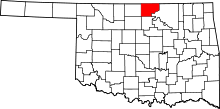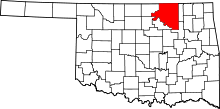Ponca City, Oklahoma
| Ponca City, Oklahoma | |
|---|---|
| City | |
|
Veteran's Day Parade down Grand Avenue in front of the Ponca City Civic Center and Town Hall | |
|
Location of Ponca City, Oklahoma | |
| Coordinates: 36°42′45″N 97°4′21″W / 36.71250°N 97.07250°WCoordinates: 36°42′45″N 97°4′21″W / 36.71250°N 97.07250°W | |
| Country | United States |
| State | Oklahoma |
| Counties | Kay, Osage |
| Founded | 1893[1] |
| Incorporated | 1899[1] |
| Government | |
| • Type | Council - Manager |
| • Mayor | Homer Nicholson |
| • Vice-Mayor | Diane Anderson |
| Area | |
| • Total | 19.3 sq mi (50.0 km2) |
| • Land | 18.1 sq mi (46.9 km2) |
| • Water | 1.2 sq mi (3.1 km2) |
| Elevation | 1,010 ft (308 m) |
| Population (2010) | |
| • Total | 25,389 |
| • Density | 1,382/sq mi (533.5/km2) |
| Time zone | Central (CST) (UTC-6) |
| • Summer (DST) | CDT (UTC-5) |
| ZIP codes | 74601-74604 |
| Area code(s) | 580 |
| FIPS code | 40-59850[2] |
| GNIS feature ID | 1096815[3] |
| Website |
poncacityok |
Ponca City is a city in Kay County and in Osage County in the U.S. state of Oklahoma, which was named after the Ponca Tribe. Ponca City had a population of 25,387 at the time of the 2010 census.
History
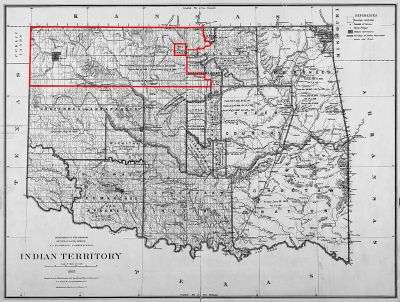
Ponca City was created in 1893 as New Ponca after the United States opened the Cherokee Outlet for European-American settlement during the Cherokee Strip land run, the largest land run in United States history.[1] The site for Ponca City was selected for its proximity to the Arkansas River and the presence of a fresh water spring near the river. The city was laid out by Burton Barnes, who drew up the first survey of the city and sold certificates for the lots he had surveyed. After the drawing for lots in the city was completed, Barnes was elected the city's first mayor.[4]
Another city, Cross, vied with Ponca City to become the leading city in the area. After the Atchison, Topeka and Santa Fe Railway had opened a station in Cross, people thought it would not open another in Ponca City because of the two cities' proximity.[4] New Ponca boosters eventually secured a station after offering the Santa Fe station agent two town lots and the free relocation of his house from Cross.[5] Ponca City reportedly obtained its first boxcar station by some Ponca City supporters going to Cross and returning with the town's station pulled behind them.[4] Cross eventually became defunct. In 1913 New Ponca changed its name to Ponca City.[5]
Petroleum industry
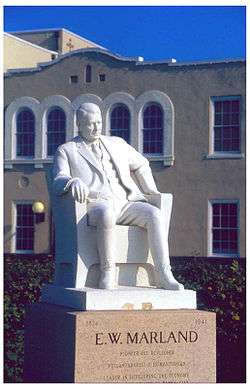
Ponca City's history and economy has been shaped chiefly by the ebb and flow of the petroleum industry. E. W. Marland, a Pennsylvania oil man, came to Oklahoma and founded the Marland Oil Company, which once controlled approximately 10 percent of the world's oil reserves.[6] He founded the 101 Ranch Oil Company, located on the Miller Brothers 101 Ranch, and drilled his first successful oil well on land which he leased in 1911 from the Ponca Tribe of American Indians.[7] He was elected in 1932 as a U.S. congressman and in 1934 as governor of Oklahoma.
Marland's exploitation of oil reserves generated growth and wealth that were previously unimaginable on the Oklahoma prairie, and his company virtually built the city from the ground up. Marland and his associates built mansions to display their new wealth, including the Grand Home and the E.W. Marland Estate (once called the Palace on the Prairie.) Because of this period of wealth and affluence, Ponca City has a high concentration of buildings that exemplify the popular Spanish Colonial Revival architecture of the period, as well as art deco-influenced buildings and homes.
The "Roaring 20s" came to an end for Ponca City shortly before the Great Depression. After a successful takeover bid by J.P. Morgan, Jr., son of financier J.P. Morgan, Marland Oil Co. merged with Continental Oil Co. (Conoco) in the late 1920s.[7] It was known as Conoco for more than 70 years. The company maintained its headquarters in Ponca City until 1949 and continued to grow into a global corporation.
During the oil boom years of the 1980s, Conoco was owned by the DuPont Corp., which took control of the company in 1981.[7] After nearly two decades of ownership and an oil bust that crippled Oklahoma's economy in the late 1980s, DuPont sold off its Conoco assets in 1998.[7] In 2002, Conoco had merged with Phillips Petroleum (another major petroleum player with roots in northern Oklahoma) to become ConocoPhillips.[7] ConocoPhillips was then the sixth-largest publicly traded oil company in the world, and the third largest in the United States.[7] It maintains a significant presence in its historic home state.
Since the company has reduced its workforce and facilities in the city, the population has declined steadily since the early 1990s. In February 2009, ConocoPhillips announced that all of its remaining non-refinery operations in Ponca City (representing 750 jobs) would be moved out of the city.[8] The city's recent efforts to grow its economy beyond the petroleum industry have attracted a number of technology, manufacturing and service jobs.
In 2005, ConocoPhillips announced plans to build a $5 million museum across from its Ponca City refinery. Opened to the public in May 2007, the Conoco Museum features artifacts, photographs and other historical items related to the petroleum industry and its culture in northern Oklahoma. A sister museum, Phillips Petroleum Company Museum, will be opened in Bartlesville, Oklahoma. Funded by a private foundation, the Conoco Museum charges no admission fee.
In 2012 ConocoPhillips split into two separate companies, with the upstream portion retaining the ConocoPhillips name and the refining and transportation portions taking the name Phillips66.
Based in Houston, Texas, Phillips66 continues to operate a 200 thousand barrel per day refinery in Ponca City.
Native Americans
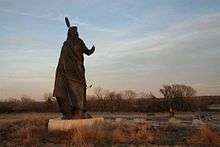

Until recently, European Americans' accounts of their settlement and the growth of the oil industry in Ponca City have often overshadowed both the long ancient history of indigenous peoples in the area, as well as those tribes who were resettled to Oklahoma in the nineteenth century under Indian Removal. The long history of the area's Native American population and its influences on the culture and history of the city and its environs.
Ponca City is named after the Ponca Tribe, part of which was relocated from Nebraska to northern Oklahoma from 1877 to 1880. Like all of the forced American Indian removals of the 19th century, the Poncas' trek was arduous. Followed by the government's failure to provide adequate supplies, as well as malaria at their destination, nearly one-third of the Ponca died from illness and exposure. "Out of 700 Ponca who left the Nebraska reservation, 158 died in Oklahoma within two years."[9]
The Ponca protested their conditions. Standing Bear's oldest son died in 1879. The chief had promised to bury him in his homeland, and about 60 Ponca accompanied him back to Nebraska. The US Army was ordered to arrest them for having left the reservation, and they were confined to Fort Omaha. Most of the tribal members who left eventually returned to the reservation in Oklahoma.[10] With the aid of prominent attorneys working pro bono, Standing Bear filed a writ of habeas corpus challenging his arrest. The case of Standing Bear v. Crook (1879) was a landmark decision in the US District Court, where the judge ruled that Indians had the same legal rights as other United States citizens.
A statue was erected in his honor at the intersection of Highway 60 and Standing Bear Parkway in Ponca City. In the late twentieth century, the city developed a park and museum, named in his honor.
The Ponca Nation, which has kept its headquarters south of Ponca City since 1879, played a major part in the development of the Marland Oil Co. and the city. Chief White Eagle leased resource-containing portions of the tribe's allotted land to E.W. Marland in 1911 for oil exploration and development.
Since the late 20th century, the Ponca Tribe has worked to build its infrastructure and improve services for its people. In February 2006, the tribe received a grant of more than $800,000 from the Shakopee Mdewakanton Sioux Community of Minnesota for debt retirement and economic development.
Nearby north-central tribes are the Kaw, Osage, Otoe-Missouria, Pawnee and Tonkawa. These are all federally recognized tribes, as is the Ponca Tribe of Indians of Oklahoma. In 1994 the six tribes established the Standing Bear Foundation and Pow-wow, beginning the first of annual shared pow-wows, to which they invite the public. They wanted to build collaboration among the tribes and with the non-Native residents of Ponca City. The pow-wow is now held in Standing Bear Park, which was named in honor of the notable Ponca chief.
Geography
Ponca City is located at 36°42′45″N 97°4′21″W / 36.71250°N 97.07250°W (36.712422, -97.072431). Ponca City lies on approximately 18.1 square miles (46.9 km2) of land, and also has approximately 1.2 sq mi (3.1 km2) of water, for a total area of 19.3 square miles (50.0 km2).
Ponca City is located in north central Oklahoma, it lies approximately 18 miles (29 km) south of the Kansas border, and approximately 15 miles (24 km) east of Interstate 35.
The city is near the Arkansas River, the Salt Fork of the Arkansas River, Kaw Lake, and Lake Ponca, which all provide numerous recreational opportunities.
Climate

The Ponca City region of Oklahoma is part of tornado alley. Tornadoes are most common in April, May and June. The photo shows a historic photo of a classic wide tornado funnel taken near Ponca City between 1890 and 1920. Ponca City faces very hot and humid summers known to average over 100 F as well as severe storms. During the winters, Ponca City consists of mostly mild to strong winters with snowstorms and ice.
| Climate data for Ponca City Regional Airport (KPNC) | |||||||||||||
|---|---|---|---|---|---|---|---|---|---|---|---|---|---|
| Month | Jan | Feb | Mar | Apr | May | Jun | Jul | Aug | Sep | Oct | Nov | Dec | Year |
| Average high °F (°C) | 43.7 (6.5) |
50.8 (10.4) |
60.7 (15.9) |
70.8 (21.6) |
79.0 (26.1) |
88.1 (31.2) |
94.1 (34.5) |
93.2 (34) |
83.9 (28.8) |
72.7 (22.6) |
57.7 (14.3) |
46.9 (8.3) |
70.1 (21.2) |
| Daily mean °F (°C) | 33.8 (1) |
39.7 (4.3) |
49.2 (9.6) |
58.9 (14.9) |
68.2 (20.1) |
77.5 (25.3) |
82.9 (28.3) |
81.9 (27.7) |
73.0 (22.8) |
61.3 (16.3) |
47.4 (8.6) |
37.1 (2.8) |
59.24 (15.14) |
| Average low °F (°C) | 23.8 (−4.6) |
28.6 (−1.9) |
37.6 (3.1) |
47.0 (8.3) |
57.3 (14.1) |
66.8 (19.3) |
71.6 (22) |
70.5 (21.4) |
62.0 (16.7) |
49.8 (9.9) |
37.1 (2.8) |
27.3 (−2.6) |
48.3 (9.1) |
| Average precipitation inches (mm) | 1.18 (30) |
1.41 (35.8) |
2.94 (74.7) |
3.51 (89.2) |
4.92 (125) |
4.50 (114.3) |
3.43 (87.1) |
3.36 (85.3) |
3.67 (93.2) |
3.23 (82) |
2.59 (65.8) |
1.67 (42.4) |
36.41 (924.8) |
| Source: National Weather Service[11] | |||||||||||||
Demographics
| Historical population | |||
|---|---|---|---|
| Census | Pop. | %± | |
| 1900 | 2,528 | — | |
| 1910 | 2,521 | −0.3% | |
| 1920 | 7,051 | 179.7% | |
| 1930 | 16,136 | 128.8% | |
| 1940 | 16,794 | 4.1% | |
| 1950 | 20,180 | 20.2% | |
| 1960 | 24,411 | 21.0% | |
| 1970 | 25,940 | 6.3% | |
| 1980 | 26,238 | 1.1% | |
| 1990 | 26,359 | 0.5% | |
| 2000 | 25,919 | −1.7% | |
| 2010 | 25,387 | −2.1% | |
| Est. 2015 | 24,758 | [12] | −2.5% |
| Sources:[2][13][14][15][16][17] | |||
At the 2010 census,[2] there were 25,387 people, 10,440 households and 7,019 families residing in the city. The population density was 1,431.0/sq mi (552.5/km2). There were 11,950 housing units at an average density of 655.4/sq mi (253.1/km2). The racial makeup of the city was 84.18% White, 2.99% African American, 6.27% Native American, 0.70% Asian, 0.03% Pacific Islander, 2.08% from other races, and 3.75% from two or more races. Hispanic or Latino of any race were 4.43% of the population.
There were 10,440 households of which 25.4% had children under the age of 18 living with them, 51.3% were married couples living together, 11.1% had a female householder with no husband present, and 34.0% were non-families. 30.0% of all households were made up of individuals and 13.7% had someone living alone who was 65 years of age or older. The average household size was 2.38 and the average family size was 2.95.
26.2% of the population were under the age of 18, 8.5% from 18 to 24, 25.5% from 25 to 44, 22.1% from 45 to 64, and 17.7% who were 65 years of age or older. The median age was 38 years. For every 100 females there were 90.7 males. For every 100 females age 18 and over, there were 85.8 males.
The median household income was $39,023, and the median family income was $38,839. Males had a median income of $32,283 and females $20,098. The per capita income was $22,566. About 12.7% of families and 17.7% of the population were below the poverty line, including 23.6% of those under age 18 and 9.3% of those age 65 or over.
Economy
Phillips 66 has 1,500 employees and 650 contractors in its facilities in Ponca City. The company has a credit card center, a refining complex, a technology research center and a transportation office. The Ponca City Refinery, operated by Phillips66, is the largest refinery in the state of Oklahoma.[18]
E. W. Marland built the Ponca City refinery in 1918 and founded the Marland Oil Company. In 1929, the Continental Oil Company merged with Marland, and the two became Conoco Inc. The Conoco headquarters were in Ponca City until 1949, when it moved to Houston, Texas. In 2002 Conoco Inc. and Phillips Petroleum Company, whose headquarters were in nearby Bartlesville, Oklahoma merged into ConocoPhillips.[18]
Tourism
Sports
Ponca City hosted minor league baseball from the 1920s through the 1950s. The Ponca City Poncans played from 1923-26, the Ponca City Angels played from 1934–1938 (winning three Western Association championships) and the Ponca City Dodgers (an affiliate of the Brooklyn Dodgers) operated from 1947–1952, Finally, the Ponca City Jets played in the Sooner State League in 1954, only to be replaced by a new club called the Ponca City Cubs in 1955, the last season of pro baseball in Ponca City.
Points of interest
- 101 Ranch Memorial
- Cann Memorial Botanical Gardens
- Conoco Museum
- Hutchins Memorial
- Kaw Lake
- Lake Ponca
- Lew Wentz Public Pool and Golf Course
- Marland Grand Home
- E. W. Marland Mansion
- Pioneer Woman Statue and Museum
- Ponca Tribe Headquarters
- Standing Bear Memorial
Landmarks
Ponca City is home to several landmarks on the National Register of Historic Places including the Poncan Theatre, the Marland Mansion and Marland's Grand Home. Ponca City also holds several regional events each year.
Pioneer Woman statue and museum

Ponca City is the site of the Pioneer Woman Museum and the Pioneer Woman statue. The statue was erected to commemorate women pioneers. In the early 1920s, E. W. Marland decided to create a statue commemorating the Pioneer Woman.[19] Marland was reportedly asked, "E. W., why don't you have ... a statue to the vanishing American, a Ponca, Otoe, or an Osage - a monument of great size?" Marland answered, "the Indian is not the vanishing American - it's the pioneer woman."[19] He sponsored a competition for the winning statue.
In 1927, miniature 3 feet (0.9 m) sculptures were submitted as part of a competition by 12 U.S. and international sculptors: John Gregory, Maurice Sterne, Hermon Atkins MacNeil, James Earle Fraser, Alexander Stirling Calder, Wheeler Williams, Mario Korbel, F. Lynn Jenkins, Mahonri Young, Arthur Lee, Jo Davidson and Bryant Baker. They were displayed in twelve cities around the state, where they were viewed by 750,000 people who voted for their favorite. The twelve original submissions have been on display at the museum at Woolaroc near Bartlesville, Oklahoma since the 1930s. Marland sold them to Frank Phillips after losing control of the Marland Oil Company.
The British-born American sculptor Bryant Baker was chosen as the winner. His full-scale work was unveiled in a public ceremony on April 22, 1930. Forty thousand guests came to hear Will Rogers pay tribute to Oklahoma's pioneers. The statue is 27 feet (8.2 m) high and weighs 12,000 pounds.
A related museum commemorating Oklahoma women was opened on September 16, 1958, on the 65th anniversary of the Cherokee Strip land run.[20] It recognizes the work of Native American as well as European-American women, and their leadership and stamina in creating homes, raising children and taking care of the work of sustaining life and communities.
Education

Public education
Ponca City Public Schools serves the general population's education requirements. Ponca City Public Schools serves over 5100 students.
- High schools
- Ponca City High School (Po-Hi) - serves all 9th through 12th grade students in the school district.
- Ombudsman Alternative Education Center - had provided select students the option to take a mostly technology-based route through high school. Ombudsman Alternative Education Center was closed after the end year of 2012-2013.
- WildCat Academy Program - starting in the 2013-2014 year became the new alternative school for high school students in the area. Sponsoring the Ponca City WildCat logo, with new changes from the Ombudsman and past alternative schools.
- Middle schools
- East Middle School - East Middle School serves Ponca City's approximately 380 8th grade students in the Ponca City Public School system.
- West Middle School - West Middle School serves all of the district's 6th and 7th grade students
- Elementary schools
Ponca City has currently seven elementary schools to serve the district's Pre-K through 5th grade students:
- Garfield Elementary
- Liberty Elementary
- Lincoln Elementary
- Roosevelt Elementary
- Trout Elementary
- Union Elementary
- Washington Elementary (became the Alternative School, but was closed at the end of the 2009-2010 school year.) (The school later reopened in 2015 as an elementary school.)
- Woodlands Elementary
Private education
Ponca City has three private schools that serve students from pre-K through 8th grade:
- Ponca City Christian Academy
- First Lutheran School
- St. Mary's Catholic School
Higher education
- Pioneer Technology Center serves high school and adult students from throughout the surrounding area. PTC also has co-operative degree programs with Northern Oklahoma College and Cowley County Community College
- University Learning Center offers interactive television (ITV) classes from several area universities, including Northern Oklahoma College, Oklahoma State University and The University of Oklahoma
- Research facilities
- Ponca City is the headquarters for Oklahoma State University's University Multispectral Laboratory.
Infrastructure
Electricity
The Ponca City region receives electricity powered hydro-electrically at Kaw Lake, a United States Army Corps of Engineers project. The facility, located seven miles (11 km) east of Ponca City, dams the Arkansas River. The electric utility is managed by the Oklahoma Municipal Power Authority (OMPA) of Edmond, Oklahoma.
Transportation
The city is served by the Ponca City Regional Airport (PNC), and is accessible by US-60, US-77, US-177, OK-11, and I-35.
On Grand Avenue( Business U.S.60 ), there are a series of new lamp posts that are intended to look more classic. This project is to replace every traffic light along Grand avenue in exception of the traffic signals at 14th st. and at Waverly. These new traffic signals are to match the new lamp posts and to give the street a more classic look.[21]
Airport
Ponca City Regional Airport (airport code PNC) (1007 feet above mean sea level) is located at the northwest corner of the city at 36 degrees 43.84 north latitude and 97 degrees 05.99 west longitude. The facility has a 7,201 foot 17-35 runway which is 150 feet (46 m) wide, and the un-towered facility has a full-length taxiway. The local airport booster club hosts a fly-in breakfast every first Saturday of the month, year around, "rain or shine".
Notable people
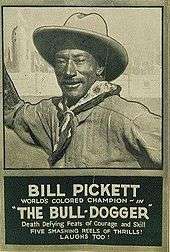
- Douglas Blubaugh, 1960 Olympic Gold Medalist in wrestling
- Mike Boettcher, news correspondent, CNN and NBC
- Lou Clinton, Major League Baseball player
- Clint Sodowsky, Major League Baseball player
- Stanley Ann Dunham, mother of U.S. President Barack Obama
- Richard E. Killblane, military historian and author
- Jon Kolb, former offensive lineman with the Pittsburgh Steelers
- Brandie Knight, author and film producer
- Candy Loving, Playboy Playmate, January, 1979
- Kim Manning, musician
- E. W. Marland, businessman and politician
- Gale McArthur, All-American basketball player at Oklahoma State University
- W. H. McFadden, oilman and philanthropist
- Jake McNiece (1919–2013), US Army paratrooper in World War II. He was the leader of the Filthy Thirteen, an elite demolition unit whose exploits inspired the novel and movie The Dirty Dozen.
- Don Nickles, former United States Senator
- Bill Pickett, cowboy
- Don Puddy, NASA Flight Director
- Mark and Rusty Ryal, father and son Major League Baseball players.
- Kareem Salama, country and western singer
- Standing Bear, Poncan Native American leader
- Anthony Taylor, Catholic Bishop of the Diocese of Little Rock, Arkansas
- Joyce Carol Thomas, children's author
- Lew Wentz, oilman and philanthropist
- Shelby Wilson, 1960 Olympic Gold Medalist in wrestling
Gallery
 The Marland Mansion
The Marland Mansion- The Poncan Theatre was built in 1927
In popular culture
Ponca City was one of the filming locations for 1996 movie Twister.[22]
In the cartoon series The Rocky and Bullwinkle Show, Bullwinkle is said to have relatives in Ponca City.[23]
In an episode of The Rockford Files, James Garner, a native Oklahoman, mentions Ponca City.
A film about E. W. Marland is expected to be in production to shoot in Ponca City, titled The Ends of the Earth. The film will star the Academy Award winner Jennifer Lawrence. Production was expected to start in 2014.
Sister cities
See also
References
- 1 2 3 William D. Halsey, ed. (1976). "Ponca City". Collier's Encyclopedia. 19. Macmillan Educational Corporation. p. 236.
- 1 2 3 "American FactFinder". United States Census Bureau. Retrieved 2008-01-31.
- ↑ "US Board on Geographic Names". United States Geological Survey. 2007-10-25. Retrieved 2008-01-31.
- 1 2 3 Louis Seymour Barnes, "The Founding of Ponca City", Chronicles of Oklahoma 35 (Summer 1957).
- 1 2 Paula Carmack Denson, "Ponca City", Encyclopedia of Oklahoma History and Culture, retrieved March 6, 2015
- ↑ Aptman, Patti, Lydie's Legend: E.W. Marland's Tragic Love, 1995, p. 4
- 1 2 3 4 5 6 Conoco Inc. Company History at Conoco Phillips company website (retrieved March 2, 2010).
- ↑ Rod Walton, "750 jobs in Ponca City will move: All ConocoPhillips non-refinery work is leaving town", Tulsa World, February 18, 2009.
- ↑ Federal Writers' Project, Nebraska: A Guide to the Cornhusker State, Works Projects Administration for the State of Nebraska, Lincoln: University of Nebraska Press, 1939, reprinted 1979, p. 36
- ↑ "The Ponca Trail of Tears: Standing Bear Returns and Is Arrested". The Trial of Standing Bear. Nebraska Studies. Retrieved 2010-09-14.
- ↑ "National Climatic Data Center" (PDF). National Oceanic & Atmospheric Administration. Retrieved 2011-02-11.
- ↑ "Annual Estimates of the Resident Population for Incorporated Places: April 1, 2010 to July 1, 2015". Retrieved July 2, 2016.
- ↑ "Population-Oklahoma" (PDF). U.S. Census 1910. U.S. Census Bureau. Retrieved 22 November 2013.
- ↑ "Population-Oklahoma" (PDF). 15th Census of the United States. U.S. Census Bureau. Retrieved 27 November 2013.
- ↑ "Number of Inhabitants: Oklahoma" (PDF). 18th Census of the United States. U.S. Census Bureau. Retrieved 22 November 2013.
- ↑ "Oklahoma: Population and Housing Unit Counts" (PDF). U.S. Census Bureau. Retrieved 22 November 2013.
- ↑ "Incorporated Places and Minor Civil Divisions Datasets: Subcounty Population Estimates: April 1, 2010 to July 1, 2012". U.S. Census Bureau. Retrieved 25 November 2013.
- 1 2 "ConocoPhillips Announces Museum Plans For Ponca City and Bartlesville." ConocoPhillips. May 13, 2005. Retrieved on January 22, 2010.
- 1 2 John Joseph Mathews, Life and Death of an Oilman: The Career of E.W. Marland, University of Oklahoma Press, 1974
- ↑ "The Museum". Pioneer Woman Museum. The Pioneer Woman Museum. Retrieved 2010-09-14.
- ↑ "Ponca City Main Street".
- ↑ "Filming Locations". Twister (1996). Internet Movie Database. Retrieved 2010-09-14.
- ↑ Rocky and His Friends, season 2, episode 38.
- ↑ "City Hall Self-Guided Tour". Ponca City Web Site. Ponca City Publishing Company. Retrieved 2010-09-14.
External links
| Wikimedia Commons has media related to Ponca City, Oklahoma. |
- Official website
- Ponca City News
- Ponca City Development Authority
- The Conoco Museum
- Articles, Attractions, and Photos of Ponca City
- Calendar of Events in Ponca City
- Oklahoma Digital Maps: Digital Collections of Oklahoma and Indian Territory

